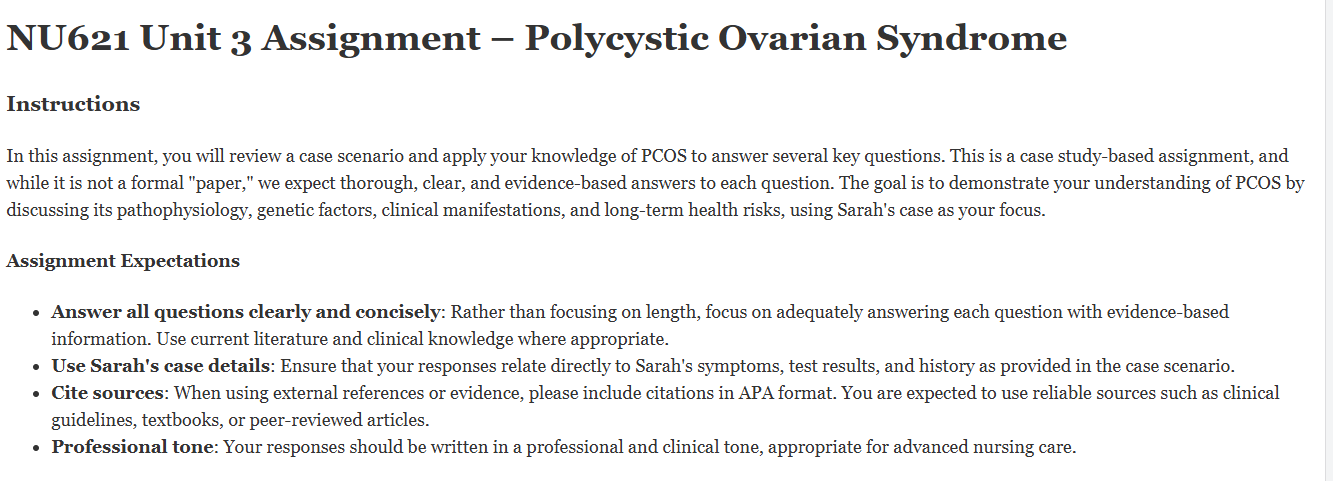NU621 Unit 3 Assignment – Polycystic Ovarian Syndrome
Instructions
In this assignment, you will review a case scenario and apply your knowledge of PCOS to answer several key questions. This is a case study-based assignment, and while it is not a formal “paper,” we expect thorough, clear, and evidence-based answers to each question. The goal is to demonstrate your understanding of PCOS by discussing its pathophysiology, genetic factors, clinical manifestations, and long-term health risks, using Sarah’s case as your focus.
Assignment Expectations
- Answer all questions clearly and concisely: Rather than focusing on length, focus on adequately answering each question with evidence-based information. Use current literature and clinical knowledge where appropriate.
- Use Sarah’s case details: Ensure that your responses relate directly to Sarah’s symptoms, test results, and history as provided in the case scenario.
- Cite sources: When using external references or evidence, please include citations in APA format. You are expected to use reliable sources such as clinical guidelines, textbooks, or peer-reviewed articles.
- Professional tone: Your responses should be written in a professional and clinical tone, appropriate for advanced nursing care.
Case Scenario
Sarah is a 28-year-old female who presents to the clinic with concerns about irregular periods and recent weight gain. She reports that her menstrual cycles have been unpredictable since her teenage years, with cycles ranging from 35 to 90 days. Sarah has also noticed an increase in facial hair and acne over the past year. She and her partner have been trying to conceive for the last 12 months without success. Her past medical history is significant for obesity, and she has gained 20 pounds over the last year despite attempting diet changes.
Sarah’s family history includes type 2 diabetes in both her parents. She denies any history of thyroid disease or significant medical problems. On physical examination, Sarah has a BMI of 33 kg/m², acanthosis nigricans on her neck, and hirsutism on her chin and upper lip. Her pelvic examination is normal, and no ovarian masses are palpated.
Initial lab work reveals the following:
- Luteinizing hormone (LH): 32 IU/L
- Follicle-stimulating hormone (FSH): 19.2 IU/mL
- Total testosterone: 80 ng/dL
- TSH: 2.1 µU/mL
- Prolactin: 300 ng/mL
- Fasting glucose: 110 mg/dL
- Fasting insulin: 18 µU/mL
Imaging: An ultrasound of Sarah’s ovaries shows multiple small cysts on both ovaries.
After reading the above scenario, please respond to the following questions in a Word document:
- Discuss the pathophysiology of polycystic ovarian syndrome (PCOS) and how it relates to Sarah’s condition.
- Explain the role of genetic factors in the development of PCOS.
- Based on Sarah’s presentation and lab results, discuss the clinical manifestations of PCOS in her case.
- Identify the potential long-term health risks associated with PCOS, considering Sarah’s family and personal health history.
While there is no specific word count, ensure that each question is fully addressed with enough detail to demonstrate a comprehensive understanding of the topic.
Complete this assignment and submit it to this assignment dropbox by Sunday at 11:59 pm CT.
Estimated time to complete: 4 hours.
SOLUTION NU621 Unit 3 Assignment – Polycystic Ovarian Syndrome
- Discuss the pathophysiology of polycystic ovarian syndrome (PCOS) and how it relates to Sarah’s condition.
Polycystic ovarian syndrome is a heterogeneous disorder that presents itself in many ways and phenotypes (an observable trait). The more criteria the person meets the more severe it is. The majority cause in individuals is the ovaries secreting an imbalance of hormones creating an excess of male hormones.
In order to be diagnosed with this condition you would have to meet two of these conditions: irregular menstrual, hyperandrogenism appearance of polycystic ovaries on ultrasonography…..
Kindly click the purchase icon below to buy the full solution at $10
(FINAL ANSWER) NU621 Unit 4: Discussion: Digestive Alterations

